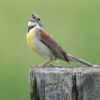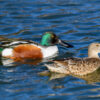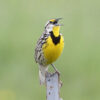The BirdSafeSTL Project – Fall 2020 Survey Results
Published in the December 2020 Tale Feathers Newsletter
Jean Favara
St. Louis Audubon Society recently launched a new project that focuses on making our urban and suburban areas safer for birds throughout the year, but especially during migration periods in the spring and fall. The BirdSafeSTL project seeks to establish long-term community relationships that support bird-safe practices and reduce bird fatalities in the St. Louis region.
St. Louis sits beneath the Mississippi Flyway, one of the major migration corridors in the United States. The Mississippi flyway is used by 60% of North American songbirds and 40% of North American waterfowl. That encompasses over 325 different bird species out of the 900+ species that can be found in the United States. In 2019, researchers from Cornell Lab of Ornithology used geography, radar data recording bird movement, and light pollution data to rank the danger to migrating birds across major US cities. St. Louis was ranked as the 5th most dangerous city during spring migration and the 6th most dangerous city during fall migration.
Birds face many challenges in the St. Louis urban and suburban environment including light pollution, glass (transparent or reflective), as well as landscaped areas used for foraging or refuge that are next to glass windows. To help us understand these dangers in downtown St. Louis landscape, 18 volunteers worked in teams three mornings per week from September 1rst through October 15th to survey downtown St. Louis for dead or injured birds. The survey focused on 19 buildings, although data on any dead or injured bird encountered in that area during the survey period was recorded. Buildings were chosen based on historical bird mortality survey data collected from 2000-2003 and on the presence of structural elements that are likely dangerous to migrating birds. The graph below illustrates the numbers of dead or injured birds found throughout the survey period.

Total dead or injured birds for the survey period was 235. Survey days showing a higher number of dead or injured birds were often proceeded by nights with high migration intensities as forecasted by BirdCast (birdcast.info). The total number of dead or injured birds found during the survey period is likely a significant undercount as the surveys were not daily checks, there was cleaning by maintenance crews in the survey areas before volunteers arrived, there were areas of buildings not accessible to survey volunteers, and the data does not reflect birds that were stunned but flew away before identified. The top five species found during the survey period include the following: 1) Ovenbird, 2) Common Yellowthroat, 3) Yellow-bellied Sapsucker, 4) Northern Waterthrush and 5) White-throated Sparrow. This species list has representatives of species breeding in our area (Ovenbird and Common Yellowthroat) migrants that move through (Northern Waterthrush) and species that overwinter in the St. Louis region (White-throated Sparrow and Yellow-bellied Sapsucker), suggesting the survey period covered many of the expected fall migration patterns.
This, and other data collected by the volunteers, is an important first step to understanding the magnitude and the landscape of the dangers faced by migrating birds in downtown St. Louis. The BirdSafeSTL committee will use this information to guide the next activities of the project including continuing surveys during the spring and fall migration periods of 2021, determining the “lightscape” of this area of downtown St. Louis at night, recruiting businesses to participate in a planned Lights Out campaign during the spring migration of 2021 and beginning the important outreach to the community that will lead to a safer St. Louis for birds.
To learn more about the BirdSafeSTL project, visit the St. Louis Audubon Society website. If you are interested in volunteering with the BirdsafeSTL project, please visit the St. Louis Audubon Society website’s contact us page and make sure you indicate your interest in the body of your message.




